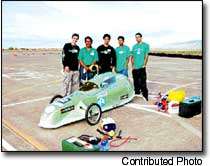The Kapa‘a High School team took top honors in the design (construction and safety) category among 25 schools statewide at Saturday’s Ninth Annual Hawaiian Electric Electron Marathon at Ford Island on O‘ahu. Kapa‘a’s space-age, aerodynamic, lime-green electric race vehicle might
The Kapa‘a High School team took top honors in the design (construction and safety) category among 25 schools statewide at Saturday’s Ninth Annual Hawaiian Electric Electron Marathon at Ford Island on O‘ahu.
Kapa‘a’s space-age, aerodynamic, lime-green electric race vehicle might have finished 12th overall, last among the finishers, but was one of the most talked about cars in years, event organizers said.
“This year’s Kapa‘a High team showed up with possibly the finest-designed and built car of the more than 200 vehicles constructed since the event began in 1996,” said Bruce Benson, a Hawaiian Electric Company (HECO) corporate communications employee. “Mercedes Benz would be proud.”
The car, created by Kapa‘a High students Dante DeMcCutac, Mason Ishiki, Arjay Balisacan and Noah Gomes, with help from teacher Rodney Yadao, was fashioned like a F-15 cockpit, said Benson.
A crowd of more than 3,000 turned out to watch 24 teams, including three from Kaua‘i’s public high schools, get to the starting line to compete in alternately misty and sunny skies on a closed, half-mile course at Ford Island in Pearl Harbor.
Of the 35 teams that originally took up the challenge, 12 cars, around one-third of the original fleet including Kapa‘a and Kaua‘i High (which finished sixth) among them, made it to the finish line.
In addition to competing for best vehicle performance on the race course, the schools also competed for best documentation, which went to Iroquois Point; best oral presentation, Sacred Hearts; and construction and safety, Kapa‘a High.
There were three best of show awards, to Iroquois Point, first; Kapolei High, second; and St. Andrews Priory, third.
Principal co-sponsors were the U.S. Navy and state Department of Education.
Other partners included Maui Electric Co., Hawaii Electric Light Co., Young Brothers, and the Hawai‘i chapter of the Sports Car Club of America.
The marathon calls for high-school teams to design, engineer, and build electric race vehicles.
Each school begins with the same small box of parts, provided by the electric companies and valued at $1,600. Students are allowed to raise outside funds and solicit parts and equipment, with a ceiling valuation not to exceed $3,000 for each vehicle.
They must adhere to a comprehensive book of rules.
Cumulative points are achieved for performance; construction and safety, including design; oral presentation; and documentation.
“We tell the high-school teams who sign up that designing, engineering and building your own electric race vehicle will be one of the toughest challenges you take on in your teen years,” said Benson.
“‘One of the HECO volunteers mentioned to me, ‘This is really great, but a little bit heartbreaking,'” Benson added. “But the challenge is so irresistible that most of the teams who didn’t get to the finish line one year come back to try again the next.”
Whether by chance or choice, the Electron Marathon also mirrors the qualities people need to succeed in the workplace, he added. Winning the race is important, but more important is how you play the game.
A team’s finish on race day counted for 30 percent of their score. The rest is made up of an oral presentation (a team’s speaking skills), documentation (a team’s writing skills), and construction and safety (a team’s technical skills).
“The best teams combine the skills of students who possess planning skills, are great with their hands, others who are ‘marketers,’ and some who can keep their heads and drive. Diverse and different — just like it takes in real life,” Benson concluded.
Staff Writer Tom Finnegan may be reached at 245-3681 (ext. 252) or mailto:tfinnegan@pulitzer.net.


